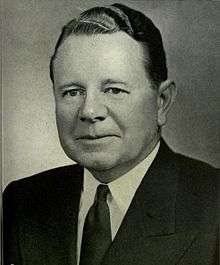John L. Sullivan (United States Navy)
John Lawrence Sullivan (June 16, 1899 – August 8, 1982) was an American lawyer who served in several positions in the US federal government, including as the first Secretary of the Navy during the administration of Harry S. Truman.
John Sullivan | |
|---|---|
 | |
| United States Secretary of the Navy | |
| In office September 17, 1947 – May 24, 1949 | |
| President | Harry S. Truman |
| Preceded by | James Forrestal |
| Succeeded by | Francis P. Matthews |
| Personal details | |
| Born | John Lawrence Sullivan June 16, 1899 Manchester, New Hampshire, U.S. |
| Died | August 8, 1982 (aged 83) Exeter, New Hampshire, U.S. |
| Political party | Democratic |
| Education | Dartmouth College (BA) Harvard University (LLB) |
Biography
Born in Manchester, New Hampshire, Sullivan was an alumnus of Dartmouth College.[1] He graduated from Harvard Law School in 1924. Sullivan served as Assistant Secretary of the Treasury in 1940–44, Assistant Secretary of the Navy (AIR) in 1945–46, and as Under Secretary of the Navy in 1946–47.
.jpg)
Sullivan was appointed Secretary of the Navy upon James Forrestal's installation as the first Secretary of Defense. Sullivan's major contributions to the Navy's future directions include the advent of naval nuclear propulsion. In 1947, then-Captain Hyman G. Rickover went around his chain-of-command and directly to the Chief of Naval Operations, Fleet Admiral Chester W. Nimitz, by chance also a former submariner, to pitch his ideas for creating a nuclear-powered warship. Nimitz immediately understood the potential of nuclear propulsion and recommended the project to Sullivan, whose endorsement to build the world's first nuclear-powered vessel, USS Nautilus (SSN-571), later caused Rickover to state that Sullivan was "the true father of the Nuclear Navy."[2][3] In May 1949, Sullivan resigned in protest after the second Secretary of Defense, Louis A. Johnson, canceled the heavy aircraft carrier United States. This event was part of an interservice conflict known as the Revolt of the Admirals.
Sullivan and his wife had two daughters and a son. Sullivan died on August 8, 1982.[4] He is buried in Arlington National Cemetery.
References
- "John L. Sullivan Papers". Truman Library. Retrieved 2007-08-20.
- LIFE magazine, September 8, 1958, page 108
- "Rye resident writes biography". seacoastonline.com. Portsmouth, New Hampshire. December 16, 2011.
- "Rites slated for John Sullivan, 83, ex-secretary of the Navy". Chicago Tribune. UPI. August 11, 1982. p. 2-12. Retrieved May 21, 2019 – via newspapers.com.
Further reading
- Clarkson, Stephen (2011). A Different Man, A Different Time: The Story of John L. Sullivan. Peter E. Randall. ISBN 978-1931807982.
External links
| Wikimedia Commons has media related to John L. Sullivan (United States Navy). |
- Sullivan's Papers at the Harry S. Truman Library & Museum
- Biography via arlingtoncemetery.net
- John L. Sullivan at Find a Grave
| Party political offices | ||
|---|---|---|
| Preceded by Henri Ledoux |
Democratic nominee for Governor of New Hampshire 1934 |
Succeeded by Amos Blandin |
| Preceded by Amos Blandin |
Democratic nominee for Governor of New Hampshire 1938 |
Succeeded by F. Clyde Keefe |
| Government offices | ||
| Preceded by Artemus Gates |
Assistant Secretary of the Navy (AIR) July 5, 1945 – June 17, 1946 |
Succeeded by John N. Brown |
| Preceded by Artemus Gates |
Under Secretary of the Navy June 17, 1946 – September 18, 1947 |
Succeeded by W. John Kenney |
| Preceded by James V. Forrestal (cabinet) |
United States Secretary of the Navy (DoD) September 18, 1947 – May 24, 1949 |
Succeeded by Francis P. Matthews |


